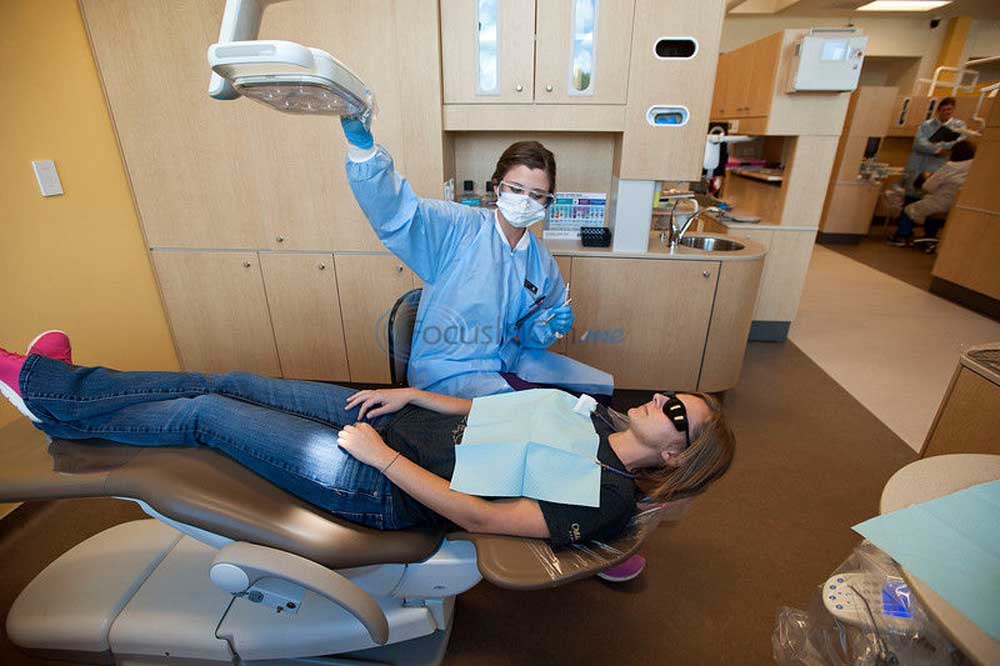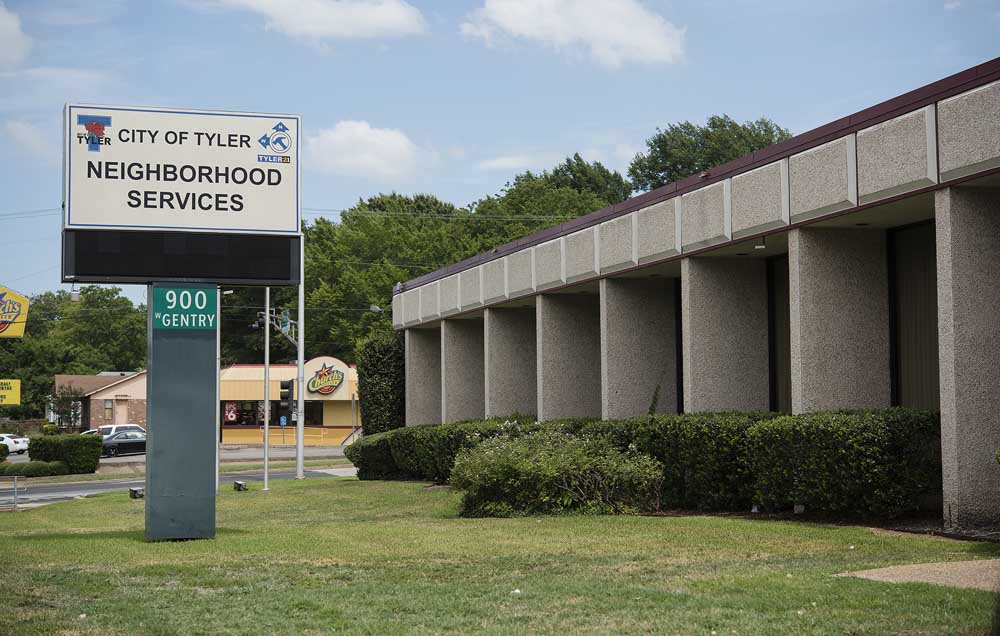Clinic educates dental students, serves the public
Published 4:15 am Tuesday, September 8, 2015

- Student Paige Carroll of Rusk gives patient Laurel Moore of Tyler a periodontal examination at the dental clinic at the Tyler Junior College Rogers Nursing and Health Sciences Center Wednesday Sept. 2, 2015. (Sarah A. Miller/Tyler Morning Telegraph)
There’s a place in Tyler where a trip to the dentist is $20 for combined services of a dental exam, cleaning, oral cancer screening, dental X-rays, fluoride treatment and dental sealants.
While the monetary cost is low, patients must be willing to make a substantial time commitment as the services are rendered by students in Tyler Junior College’s dental hygiene program; and they work very slowly since they are learning.
It could take two or more visits to TJC’s dental clinic, each lasting up to 3 1/2 hours, for a student to administer all of the comprehensive preventative dentistry treatments. Yet the charge remains a one-time fee of $20, regardless of the number of appointments.
Supervising dentists and professional dental hygienists check everything dental hygiene students do.
“It’s a very thorough treatment,” Carrie Hobbs, dental studies department chairwoman, said.
Lanora Hodgson, of Flint, has been coming to the clinic for years.
“I try to make it every six months. The clinic is top-notch; it’s a really nice place,” she said.
As for the student dental hygienists, Ms. Hodgson said, “I’ve never had a bad one. I’ve always felt comfortable with them and I feel like they do a good job. My teeth always feel clean when they get through, so I’m plenty happy with coming out here.”
On his first visit to the clinic recently, David Barnett, of Tyler, said, “It’s been a good experience. Everyone treats you with respect and they seem like they know what they are doing.”
While the clinic is open to the public, students often find and bring their own patients. Jeannie Nash, of the Gilmer area, whose husband works with the father of student Shyanne Owens of Tyler, agreed to be a patient.
“It’s been a long time since I’ve had any kind of checkup. When she called and needed a patient, I was more than happy to come up here and get myself checked out,” Ms. Nash said. “She is doing a great job. It’s a nice facility. Everybody has been really friendly.”
Students are required to put in about 700 hours in the clinic as part of their training to become a dental hygienist.
If it has been over three years since a patient has been seen by a dentist, then the clinic specialist will set that patient for a screening appointment, which takes about an hour and a half, before the patient sees a student hygienist, Ms. Hobbs said.
The clinic serves anyone from 4 years old to the elderly. Many people hear about it through word of mouth and call 903-510-2341 to arrange an appointment. Flyers providing information about the clinic are distributed.
The clinic is open during the fall semester from 8 a.m. to 5 p.m. Wednesdays and Fridays. During the spring semester, it is open from 8 a.m. to 5 p.m. Tuesdays, Wednesdays and Fridays.
“We can’t guarantee everybody gets an appointment because the students have certain types of patients they need to see in order to meet their course requirements,” Ms. Hobbs said.
Although TJC has had the clinic since the beginning of the dental hygiene education program in 1969, it moved into the new Robert M. Rogers Nursing and Health Sciences Center early this year.
In its new and spacious setting, the clinic has 33 very modern dental operatories replete with a dental chair, state-of-the-art equipment. digital X-rays and electronic patient charting.
The clinic has 17 dental oral X-ray units to take X-rays inside the mouth and three panoramic X-ray units that take X-rays around the head.
Students learn two methods or styles of delivering dental care: providing services from behind the patient’s head and providing services in front of the patient’s head.
“Dental care is one of the highest unmet needs in this area,” Ms. Hobbs said.
With the services the students provide in the clinic, she said, “we hope to help with that unmet need. The dental hygiene profession and the dental assisting profession are growing. We are meeting a need in the career end of things as well as in health care.”
Lisa Joyner, 37, of White Oak, worked 13 years in dental assisting and in the office for an orthodontist before deciding to enroll in TJC’s dental hygiene program.
“It intrigued me. I love working with patients; I don’t want to sit behind a desk all day. I want to have interaction with people,” she said.
Ms. Joyner said she would be glad to get out of school and start her career.
Dental hygiene student Kala Sellers, 22, of Lindale, said working in a patient’s mouth the first time was scary and nerve-racking, yet now she feels comfortable doing it.
“I enjoy it a lot; I’m glad that I chose dental hygiene,” she said.
“It wasn’t something I ever thought I was going to do,” Ms. Sellers said, but she decided to go for it after talking with her cousin who is a dental hygienist.
Seeing the difference after she cleaned a patient’s teeth stained from tobacco smoking “made me really happy,” she said.
Shelby Strickland, 24, originally from Longview and now living in Tyler, became interested in the field after talking with a friend who is a dental hygienist.
“It’s exciting,” she said. What she likes most about being a dental hygienist are the patients. “You get to know your patients really well and talk to them. I like that part about it and cleaning teeth. I think it’s really fun,” Ms. Strickland said.
The dental hygienist program accepts 30 students each year. Applicants must have completed most of the prerequisite 34 credit hours, which takes a little over a year, Ms. Hobbs said.
By the time students see patients, they are in the second, third and fourth semesters of the dental hygiene program as they work toward an associate degree in dental hygiene. It takes about three years to complete the program.
When they finish the program, they have an associate degree and take licensure exams, including the National Board Dental Hygiene Exam and the Western Regional Examining Board Exam.
“The licensure exams are very difficult; they have to be very prepared,” Ms. Hobbs said.
Dental hygienist and dentists are the only health care provider required to pass a clinical exam and must work on a patient during the regional exam. Upon passing the licensure exams, students become a registered dental hygienist and can work for a dentist.
With its new facility, the clinic has incorporated a partnership with UT Health Northeast and students are able to see additional patients referred from UT Health Northeast medical clinics.
In addition, UT Health Northeast provides the clinic a dentist and a dental hygienist who are able to see patients in the clinic.
In the future, the clinic is pursuing ways to provide operative dentistry, fillings, extracts and other services, Ms. Hobbs said. Service is currently limited to preventative dentistry.
Dental hygiene students also have participated in outreach events with UT Health Northeast and have had more experiences with public health alongside dentist students from Baylor School of Dentistry.
An upcoming event will be on the TJC campus Sept. 19.
In addition, dental students are going to be working with TJC dental hygiene students at the TJC clinic to provide services for clinic patients and some patients referred from UT Health Northeast, Christina Horton, dental hygienist and certified dental assistant, said.
A van supplied by the Caring for Children Foundation of Texas also is utilized as another way for dental hygiene students to go out into the public and provide services to children that are underserved and need care, Ms. Horton said.
TWITTER: @TMT_Betty






